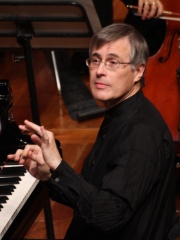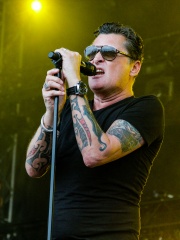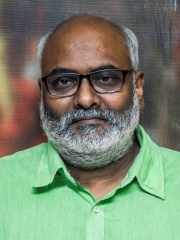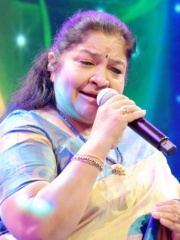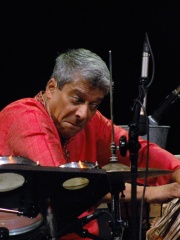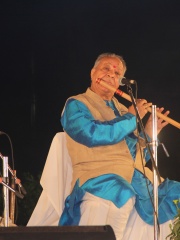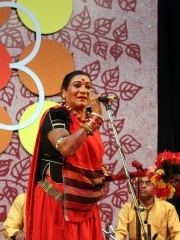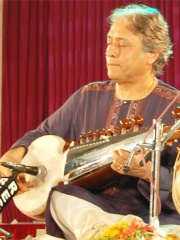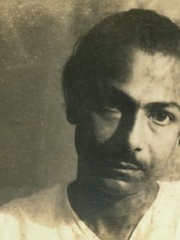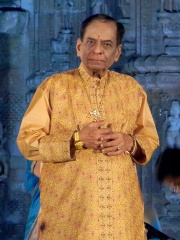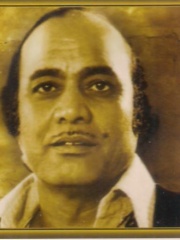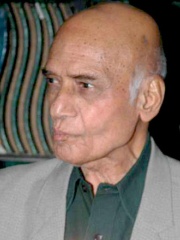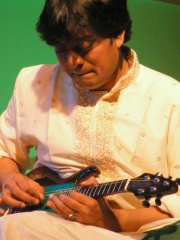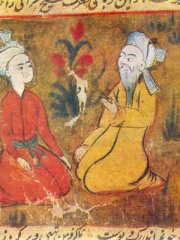
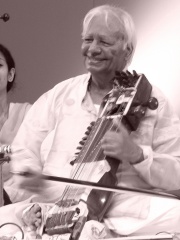
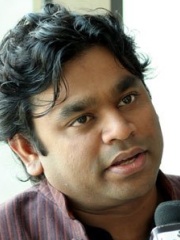
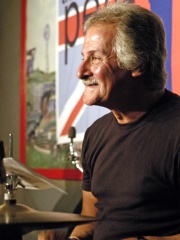
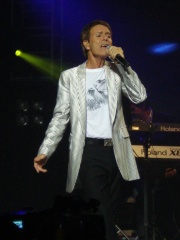
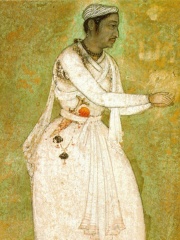
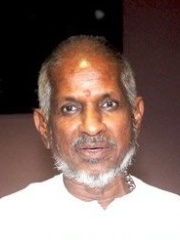
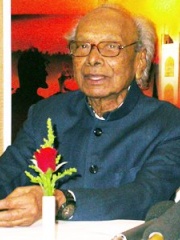
The Most Famous
MUSICIANS from India
Top 10
The following people are considered by Pantheon to be the top 10 most legendary Indian Musicians of all time. This list of famous Indian Musicians is sorted by HPI (Historical Popularity Index), a metric that aggregates information on a biography's online popularity. Visit the rankings page to view the entire list of Indian Musicians.

1. Amir Khusrow (1253 - 1325)
With an HPI of 76.92, Amir Khusrow is the most famous Indian Musician. His biography has been translated into 66 different languages on wikipedia.
Abu'l Hasan Yamīn ud-Dīn Khusrau (1253 – October 1325), better known as Amīr Khusrau, sometimes spelled as, Amir Khusrow or Amir Khusro, was an Indo-Persian Sufi singer, musician, court poet and scholar, who lived during the period of the Delhi Sultanate. He is an iconic figure in the cultural history of the Indian subcontinent. He was a mystic and a spiritual disciple of Nizamuddin Auliya of Delhi, India. He wrote poetry primarily in Persian, but also in Hindavi and Punjabi. A vocabulary in verse, the Ḳhāliq Bārī, containing Arabic, Persian and Hindavi terms is often attributed to him. Khusrau is sometimes referred to as the "voice of India" or "Parrot of India" (Tuti-e-Hind). Khusrau is regarded as the "father of qawwali" (a devotional form of singing of the Sufis in the Indian subcontinent), and introduced the ghazal style of song into India, both of which still exist widely in India and Pakistan. Khusrau was an expert in many styles of Persian poetry which were developed in medieval Persia, from Khāqānī's qasidas to Nizami's khamsa. He used 11 metrical schemes with 35 distinct divisions. He wrote in many verse forms including ghazal, masnavi, qata, rubai, do-baiti and tarkib-band. His contribution to the development of the ghazal was significant.

2. Ram Narayan (1927 - 2024)
With an HPI of 74.13, Ram Narayan is the 2nd most famous Indian Musician. His biography has been translated into 78 different languages.
Ram Narayan (IPA: [raːm naːˈɾaːjəɳ]; 25 December 1927 – 9 November 2024), often referred to with the title Pandit, was an Indian musician who popularised the bowed instrument sarangi as a solo concert instrument in Hindustani classical music and became the first internationally successful sarangi player. Narayan was born near Udaipur and learned to play the sarangi at an early age. He studied under sarangi players and singers and, as a teenager, worked as a music teacher and travelling musician. All India Radio in Lahore hired Narayan as an accompanist for vocalists in 1944. Narayan relocated to Delhi following the partition of India in 1947, and moved to Mumbai in 1949 to work in Indian cinema. Narayan became a concert solo artist in 1956, performing at the major music festivals of India. Narayan recorded solo albums and made his first international tour in 1964 to America and Europe with his older brother Chatur Lal, a tabla (hand drum) player who had toured with Ravi Shankar in the 1950s. He was awarded India's second highest civilian honour, the Padma Vibhushan, in 2005.

3. A. R. Rahman (b. 1966)
With an HPI of 69.70, A. R. Rahman is the 3rd most famous Indian Musician. His biography has been translated into 61 different languages.
Allah Rakha Rahman (; born A. S. Dileep Kumar; 6 January 1967), also known by the initialism ARR, is an Indian music composer, record producer, singer, songwriter, multi-instrumentalist, and philanthropist known for his works in Indian cinema; predominantly in Tamil and Hindi films, with occasional forays in international cinema. He is a recipient of six National Film Awards, two Academy Awards, two Grammy Awards, a BAFTA Award, a Golden Globe Award, six Tamil Nadu State Film Awards, fifteen Filmfare Awards, and eighteen Filmfare Awards South. In 2010, the Government of India conferred him with the Padma Bhushan, the nation's third-highest civilian award. With his in-house studio Panchathan Record Inn, Rahman's film-scoring career began during the early 1990s with the Tamil film Roja. Following that, he went on to score several songs for Tamil language films, including Mani Ratnam's politically charged Bombay, the urban Kaadhalan, Thiruda Thiruda, and S. Shankar's debut film Gentleman. Rahman's score for his first Hollywood film, the comedy Couples Retreat (2009), won the BMI Award for Best Score. His music for Slumdog Millionaire (2008) earned him Best Original Score and Best Original Song (for Jai Ho) at the 81st Academy Awards. He was also awarded Best Compilation Soundtrack Album and Best Song Written for Visual Media at the 2010 Grammy Awards. He is nicknamed "Isai Puyal" (transl. Musical Storm) and "Mozart of Madras". Rahman has also become a humanitarian and philanthropist, donating and raising money for a number of causes and charities. In 2006, he was honoured by Stanford University for his contributions to global music. In 2008, he received Lifetime Achievement Award from the Rotary Club of Madras. In 2009, he was included on the Time list of the world's 100 most influential people. In 2014, he was awarded an honorary doctorate from Berklee College of Music. He has also received honorary doctorate from Aligarh Muslim University. In 2017, he made his debut as a director and writer for the film Le Musk. In 2024, Rahman was named Honorary President of Trinity Laban.

4. Pete Best (b. 1941)
With an HPI of 69.42, Pete Best is the 4th most famous Indian Musician. His biography has been translated into 52 different languages.
Randolph Peter Best (né Scanland; born 24 November 1941) is a British retired musician who was the drummer for the Beatles from 1960 to 1962. He was dismissed shortly before the band achieved worldwide fame and is one of several people referred to as a fifth Beatle. Best's mother, Mona Best (1924–1988), opened the Casbah Coffee Club in the cellar of the Bests' house in Liverpool. The Beatles (at the time known as the Quarrymen) played some of their first concerts at the club. The Beatles invited Best to join the band on 12 August 1960, on the eve of the group's first Hamburg season of club dates. Ringo Starr eventually replaced Best on 16 August 1962 when the group's manager, Brian Epstein, fired Best at the request of John Lennon, Paul McCartney, and George Harrison following the band's first recording session. Over 30 years later, Best received a significant monetary payout for his work with the Beatles after the release of their 1995 compilation of their early recordings on Anthology 1; Best played the drums on 10 of the album's tracks, including the Decca auditions. After being a member of several commercially unsuccessful groups, Best left the music industry to pursue a career as a civil servant for 20 years before forming the Pete Best Band, active from 1988 until 2025.
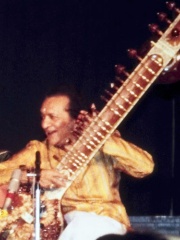
5. Ravi Shankar (1920 - 2012)
With an HPI of 69.34, Ravi Shankar is the 5th most famous Indian Musician. His biography has been translated into 91 different languages.
Pandit Ravi Shankar (Bengali pronunciation: [ˈrobi ˈʃɔŋkor]; born Robindro Shaunkor Chowdhury, sometimes spelled as Ravindra Shankar Chowdhury; 7 April 1920 – 11 December 2012) was an Indian sitarist and composer. A sitar virtuoso, he became the world's best-known exponent of Indian classical music in the second half of the 20th century, and influenced many musicians in India and throughout the world. Shankar was awarded India's highest civilian honour, the Bharat Ratna, in 1999. He is also the father of American singer Norah Jones and British-American musician and sitar player Anoushka Shankar. Shankar was born to a Bengali family in India, and spent his youth as a dancer touring India and Europe with the dance group of his brother Uday Shankar. At age 18, he gave up dancing to pursue a career in music, studying the sitar for seven years under court musician Allauddin Khan. After finishing his studies in 1944, Shankar worked as a composer, creating the music for the Apu Trilogy by Satyajit Ray, and was music director of All India Radio, New Delhi, from 1949 to 1956. In 1956, Shankar began to tour Europe and America, playing Indian classical music. He increased its popularity there in the 1960s through teaching, performance, and his association with violinist Yehudi Menuhin and Beatles guitarist George Harrison. His influence on Harrison helped popularize the use of Indian instruments in Western pop music in the latter half of the 1960s. Shankar engaged Western music by writing compositions for sitar and orchestra and touring the world in the 1970s and 1980s. From 1986 to 1992, he served as a nominated member of Rajya Sabha, the upper house of the Parliament of India. He continued to perform until the end of his life. He was a recipient of numerous prestigious musical accolades, including a Polar Music Prize and four Grammy Awards, including Album of the Year for The Concert for Bangladesh in 1973, as well as an Academy Award nomination for Best Original Score for scoring the blockbuster Gandhi (1982).

6. Cliff Richard (b. 1940)
With an HPI of 69.05, Cliff Richard is the 6th most famous Indian Musician. His biography has been translated into 57 different languages.
Sir Cliff Richard (born Harry Rodger Webb; 14 October 1940) is a British singer and actor. He has total sales of over 21.5 million singles in the United Kingdom and, as of 2012, was the third-top-selling artist in UK singles chart history, behind the Beatles and Elvis Presley. Richard was originally marketed as a rebellious rock and roll singer in the style of Presley and Little Richard. With his backing group, the Shadows, he dominated the British popular music scene in the pre-Beatles period of the late 1950s to early 1960s. His 1958 hit single "Move It" is often described as Britain's first authentic rock and roll song. He had a successful screen career with films including Expresso Bongo (1959), The Young Ones (1961), Summer Holiday (1963) and Wonderful Life (1964), and his own show on BBC Television. Increased focus on his Christian faith and subsequent softening of his music led to a more middle-of-the-road image, and he sometimes ventured into contemporary Christian music. In a career spanning over 65 years, Richard has amassed several gold and platinum discs and awards, including two Ivor Novello Awards and three Brit Awards. More than 130 of his singles, albums, and EPs have reached the UK Top 20, more than any other artist. Richard has had 67 UK top ten singles, the second highest total for an artist (behind Presley). He holds the record, with Presley, as the only act to make the UK singles charts in all of its first six decades (1950s–2000s). He has achieved 14 UK No. 1 singles, and is the only singer to have had a No. 1 single in the UK in each of five consecutive decades. He also had four UK Christmas No. 1 singles, two of which were as a solo artist; "Mistletoe and Wine" and "Saviour's Day". By the late-1990s, Richard had sold more than 250 million records worldwide, making him one of the best-selling music artists of all time. He has never achieved the same popularity in the United States despite eight US Top 40 singles, including the million-selling "Devil Woman" and "We Don't Talk Anymore". In Canada, he had a successful period in the early 1960s, the late 1970s and early 1980s, with some releases certified gold and platinum. He has remained a popular music, film, and television personality at home in the UK as well as Australia, New Zealand, South Africa, Northern Europe and Asia, and retains a following in other countries. When not touring, he divides his time between Barbados and Portugal. In 2019, he relocated to New York.

7. Tansen (1493 - 1493)
With an HPI of 66.69, Tansen is the 7th most famous Indian Musician. His biography has been translated into 27 different languages.
Rāmtanu Panday (c. 1493 – 26 April 1589), popularly referred to as Mian Tānsen (lit. 'the Learned One'), or Sangeet Samrāt (lit. 'Monarch of Hindustani Music'), was a Hindustani classical musician. Born into a Hindu Gaur Brahmin family in Gwalior, he learnt and perfected his art in the northwest region of modern Madhya Pradesh. He got his first break as musician and composer in the court of Raja Man Singh Tomar of Gwalior and spent most of his adult life in the court and patronage of the Hindu king of Rewa, Raja Ramchandra Singh Baghel (r. 1555–1592), where Tānsen's musical abilities and studies gained widespread fame. This reputation brought him to the attention of the Mughal Emperor Akbar. In 1562, at about the age of 60, Tānsen joined Akbar's court, and his performances became the subject of many court historians. Numerous legends have been written about Tānsen, mixing facts and fiction, and the historicity of these stories is doubtful. Akbar considered him one of the Navaratnas Nine Ministers (the nine jewels) and gave him the title Mian, an honorific, meaning learned man.Tansen was a great composer musician and vocalist, to whom many compositions have been attributed in the northern regions of the Indian subcontinent. He was also an instrumentalist who popularized and improved musical instruments. He is among the most influential personalities in the North Indian tradition of Indian classical music, called Hindustani. His 16th-century studies in music and compositions inspired many, and he is considered by numerous North Indian gharana (regional music schools) to be their lineage founder. Tānsen is remembered for his epic Dhrupad compositions, creating several new rāgs, as well as for writing two classic books on music, Sri Ganesh Stotra and Sangita Sara.

8. Ilaiyaraaja (b. 1943)
With an HPI of 60.56, Ilaiyaraaja is the 8th most famous Indian Musician. His biography has been translated into 25 different languages.
Ilaiyaraaja (born R.Gnanathesigan) is an Indian musician, composer, arranger, conductor, orchestrator, multi-instrumentalist, lyricist and playback singer popular for his works in Indian cinema, predominantly in Tamil in addition to Telugu, Malayalam, Kannada and Hindi films. Regarded as one of the most prolific composers, in a career spanning over forty-nine years, he has composed over 8,600 songs, provided film scores for about 1,523 feature films in nine languages, and performed in over 20,000 concerts. He is nicknamed "Isaignani" (the musical sage) and is often referred to as "Maestro", the title conferred to him by the Royal Philharmonic Orchestra, London. In 2013, when CNN-IBN conducted a poll to commemorate 100 years of Indian cinema, Ilaiyaraaja secured 49% of the vote and was adjudged the country's greatest music composer. In 2025, he became the first-ever Asian, as well as Indian film composer to compose, record, and perform live a full Western classical symphony in London. He also composed and orchestrated Thiruvasagam in Symphony (2006) - the first Indian oratorio. Ilaiyaraaja received several awards for his works throughout his career. In 2012, for his creative and experimental works in the field of music, he received the Sangeet Natak Akademi Award, the highest Indian recognition given to people in the field of performing arts. In 2010 he was awarded the Padma Bhushan, the third-highest civilian honour in India, and in 2018 the Padma Vibhushan, the second-highest civilian award by the government of India. He is a nominated Member of Parliament in the Indian upper house Rajya Sabha since July 2022. A biographical film about his life titled "Ilaiyaraaja" was announced on 20 March 2024.

9. Naushad (1919 - 2006)
With an HPI of 59.64, Naushad is the 9th most famous Indian Musician. His biography has been translated into 19 different languages.
Naushad Ali (25 December 1919 – 5 May 2006) was an Indian composer for Hindi films. He is widely considered to be one of the greatest and foremost music directors of the Hindi film industry. He is respectfully remembered as "Moseeqar-e-azam" ( The great musician) in the Hindi film industry. He is particularly known for popularising the use of classical music in films. His first film as an independent music director was Prem Nagar in 1940. His first musically successful film was Rattan (1944), followed by 35 silver jubilee hits, 12 golden jubilee and 3 diamond jubilee mega successes. Naushad was conferred the Dadasaheb Phalke Award and the Padma Bhushan in 1981 and 1992 respectively for his contribution to the Hindi film industry.
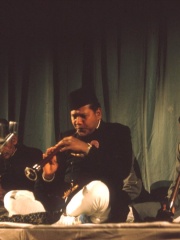
10. Bismillah Khan (1916 - 2006)
With an HPI of 59.48, Bismillah Khan is the 10th most famous Indian Musician. His biography has been translated into 35 different languages.
Ustad Bismillah Khan (born Qamaruddin Khan, 21 March 1916 – 21 August 2006), often referred to by the title Ustad, was an Indian musician credited with popularizing the shehnai, a reeded woodwind instrument. His virtuosity made him a leading Hindustani classical music artist, indelibly linking his name with the woodwind instrument. While the shehnai had importance as a folk instrument played primarily by musicians schooled in traditional ceremonies, Khan elevated its status and brought it to the concert stage. Khan was a devout Muslim but performed at both Hindu and Muslim ceremonies, and was considered a symbol of religious harmony. Owing to his fame, he was selected to perform for the ceremony at Delhi's historic Red Fort as the Indian flag unfurled at the hour of India's independence on 15 August 1947. His music was played (in Raag Kafi) on television every Independence Day. Khan turned down invitations to perform in other countries before 1966, when the Indian government insisted that he play at the Edinburgh International Festival. This gained him a following in the West, and he continued to appear in Europe and North America thereafter. In 2001, Bismillah Khan was awarded the Bharat Ratna, India's highest civilian honour, and the country observed a national day of mourning following his death in 2006. He became the third classical musician of India after M. S. Subbalakshmi and Ravi Shankar to be awarded the Bharat Ratna.
People
Pantheon has 29 people classified as Indian musicians born between 1253 and 1993. Of these 29, 17 (58.62%) of them are still alive today. The most famous living Indian musicians include A. R. Rahman, Pete Best, and Cliff Richard. The most famous deceased Indian musicians include Amir Khusrow, Ram Narayan, and Ravi Shankar. As of April 2024, 1 new Indian musicians have been added to Pantheon including Sidhu Moose Wala.
Living Indian Musicians
Go to all RankingsA. R. Rahman
1966 - Present
HPI: 69.70
Pete Best
1941 - Present
HPI: 69.42
Cliff Richard
1940 - Present
HPI: 69.05
Ilaiyaraaja
1943 - Present
HPI: 60.56
Christian Zacharias
1950 - Present
HPI: 57.00
Barry Hay
1948 - Present
HPI: 56.80
M. M. Keeravani
1961 - Present
HPI: 54.54
K. S. Chithra
1963 - Present
HPI: 54.47
Trilok Gurtu
1951 - Present
HPI: 54.36
Hariprasad Chaurasia
1938 - Present
HPI: 54.34
Teejan Bai
1956 - Present
HPI: 50.26
Amjad Ali Khan
1945 - Present
HPI: 49.90
Deceased Indian Musicians
Go to all RankingsAmir Khusrow
1253 - 1325
HPI: 76.92
Ram Narayan
1927 - 2024
HPI: 74.13
Ravi Shankar
1920 - 2012
HPI: 69.34
Tansen
1493 - 1493
HPI: 66.69
Naushad
1919 - 2006
HPI: 59.64
Bismillah Khan
1916 - 2006
HPI: 59.48
Salil Chowdhury
1925 - 1995
HPI: 53.01
M. Balamuralikrishna
1930 - 2016
HPI: 50.21
Mehdi Hassan
1927 - 2012
HPI: 49.85
Mohammed Zahur Khayyam
1927 - 2019
HPI: 45.67
U. Srinivas
1969 - 2014
HPI: 36.32
Sidhu Moose Wala
1993 - 2022
HPI: 31.09
Newly Added Indian Musicians (2025)
Go to all RankingsOverlapping Lives
Which Musicians were alive at the same time? This visualization shows the lifespans of the 9 most globally memorable Musicians since 1700.

